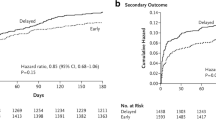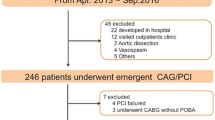Abstract
Understanding of the mechanisms, outcomes and treatment of non-Q wave myocardial infarction (NQMI) has evolved. Coexisting diabetes poses additional challenges. We studied baseline characteristics, inhospital and one-year outcomes for NQMI patients having percutaneous transluminal angioplasty.
Similar content being viewed by others
References
Gibson RS. Non-q wave myocardial infarction: Prognosis, changing incidence, and management. In: Gersh BJ, Rahimtoola SH (eds) Acute Myocardial Infarction. Current Topics in Cardiology. New York, Elsevier Science Publishing, Inc., 1991:284–307.
DeWood MA, Stiffer WF, Simpson CS. Coronary angiographic findings soon after non-q wave myocardial infarction. N Engl J Med. 1986;315:417–423.
Quigley PJ, Hlatky MA, Hinohara R, et al. Repeat percutaneous transluminal coronary angioplasty and predictors of recurrent restenosis. Am J Cardiol. 1989;63:409–413.
Gowda MS, Vacek JL, Hallas D. One year outcomes of diabetic versus nondiabetic patients with non-q wave acute myocardial infraction treated with percutaneous transluminal coronary angioplasty. Am J Cardiol. 1998;82:1067–1071.
Zaacks SM, Liebson PR, Calvin JE. Unstable angina and non-q wave myocardial infarction: Does the clinical diagnosis have therapeutic implications. J Am Coll Cardiol. 1999; 33:107–118.
The TIMI IIIB Investigators. Effects of tissue plasminogen activator and a comparison of early invasive conservative strategies in unstable angina and non-q wave myocardial infarction. Results of TIMI IIIB trial. Circulation. 1994;89: 1545–1556.
Bissett JK, Matts J, Sharma B. Residual myocardial jeopardy in patients with q-wave and non-q wave infarction. Br Heart J. 1987;58:460–464.
Huey BL, Gheorghrade M, Crampton RS, et al. Acute non-q wave myocardial infraction associated with early ST segment elevation: evidence of spontaneous reperfusion and complications for thrombolytic trials. J Am Coll Cardiol. 1987;9:18–25.
Nixon JV. Non-q wave myocardial infarction: an incomplete cardiac event requiring an aggressive approach. Postgrad Med. 1994;95:211–223.
Boden WE, O'Rourke RA, Crawford MH, et al. Outcomes in patients with acute non-q wave myocardial infarction randomly assigned to an invasive as compared with a conservative management strategy: Veterans Affairs Non-Q Wave Infarction Strategies in Myocardial Infarction (VANQWISH). J Engl J Med. 1998;338:1785–1792.
Jacobs AK, Kelsey SF, Brooks MM, et al. Better outcomes for women compared with men undergoing coronary revascularization. Circulation. 1998;98:1279–1285.
Jacobs RG, Kelsey SF, Brooks MM. Better outcomes for women compared with men undergoing coronary revascularization. Circulation. 1998;98:1279–1285.
Bergelson, BA, Tommaso CL. Gender differences in clinical evaluation and triage in coronary artery disease. Chest. 1995;108:1510–1513.
Gowda MS, Vacek JL, Hallas D. Gender related risk factors and outcomes for non-q wave myocardial infarction patients receiving inhospital PTCA. J Invas Cardiol. 1999;11:121–126.
Jacoby RM, Nesto RW. Acute myocardial infarction in the diabetic patient: physiology, clinical course and prognosis. J Am Coll Cardiol. 1992;20:736–744.
Kannel WB, McGee DL. Diabetes and cardiovascular disease: the Framingham study. JAMA. 1979;241:2035–2038.
Stein B, Weintraub WS, Gebhart SS, et al. Influence of diabetes mellitus on early and late outcome after percutaneous transluminal coronary angioplasty. Circulation. 1995;91:979–989.
Hollman J, Badhwar K, Beck GJ, Franco I, Simpfendorfer C. Risk factors for recurrent stenosis following successful coronary angioplasty. Cleve Clin J Med. 1989;63:409–413.
Weintraub WS, Ghazzal ZM, Douglas JS, et al. Initial management and long-term clinical outcome of restenosis after initially successful PTCA. Am J Cardiol. 1992;70:47–55.
Johnson RG, Sirosis C, Watkins JF, et al. CABG after successful PTCA: a case control study. Ann Thorac Surg. 1995; 59:1391–1396.
Klein W, Buchwald A. Hillis WS on behalf of the FRIC Investigators. Fragmin in unstable angina pectoris or in non-q wave acute myocardial infarction (FRIC). Am J Cardiol. 1997;80(5A):25E-29E.
Cohen M, Demers C, Gurfinkel EP. A comparison of low molecular weight heparin with unfractionated heparin for unstable coronary artery disease. N Engl J Med. 1997;337: 447–452.
Williams EB. Non-q wave myocardial infarction: a prognostic paradox. Hosp Pract. 1992;27:129–133.
Gheorghiade M, Ruzumma P, Borzak S, Havstad S, Abbas A, Goldstein S. Decline in the rate of hospital mortality from acute myocardial infarction: impact of changing management strategies. Am Heart J. 1996;13:250–256.
Mehran R, Ambrose JA, Bongu RM. Angioplasty of complex lesions in ischemic rest angina: results of the Thrombolysis And Angioplasty in Unstable Angina (TAUSA) trial. J Am Coll Cardiol. 1995;26:961–966.
Harrington RA for the PURSUIT Investigators. A symposium: acute ischemic coronary syndrome—The PURSUIT Trial. Am J Cardiol. 1997;80:36–39.
The PRISM Study Investigators. A comparison of aspirin plus tirofiban with aspirin plus for unstable angina. N Engl J Med. 1998;338:1498–1505.
The PRISM-PLUS Study Investigators. Inhibition of platelet glycoprotein IIb/IIIa receptor with tirofiban in unstable angina and non-q wave myocardial infarction. N Engl J Med. 1998;338:1429–1435.
Author information
Authors and Affiliations
About this article
Cite this article
Lakkireddy, D., Gowda, M.S., Vacek, J.L. et al. The role of angioplasty for non-Q wave myocardial infarction: The impact of diabetes on outcomes. Compr Ther 26, 269–275 (2000). https://doi.org/10.1007/s12019-000-0029-2
Received:
Accepted:
Issue Date:
DOI: https://doi.org/10.1007/s12019-000-0029-2




